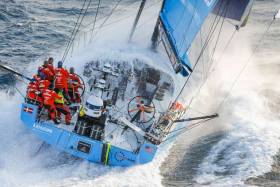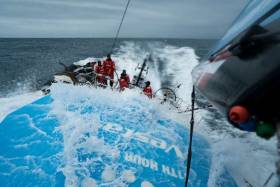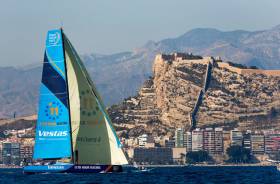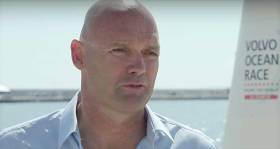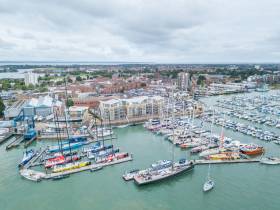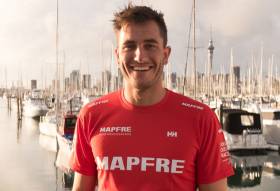Displaying items by tag: Volvo Ocean Race
Damian Foxall & Vestas Show the Way in Volvo Ocean Race
If winning sailing races is ultimately a matter of making less mistakes than anyone else, then Charlie Enright, skipper of the Volvo Ocean Race 65 Vesta 11th Hour Racing, must have registered an almost-clean sheet since starting Leg 1 from Alicante last Sunday writes W M Nixon.
And one good positive decision was the relatively late addition of Ireland’s Damian Foxall to the Vestas crew, as Foxall’s unrivalled experience always seems to give any world campaign an added edge.
Vestas has been quietly but steadily building on her lead since the start, and approaching the finish of Leg 1 in Lisbon this morning at 11.3 knots, they’re an astonishing 33.7 miles clear ahead of next in line, the Spanish entry Mapfre.
Others are even further astern, and Ireland’s other star participant, Annalise Murphy crewing as a complete rookie on Turn the Tide for Plastic, finds herself in the unusual position of battling over the final place in the seven boat fleet with Team Brunei, with the two boats are neck-and-neck 95 miles astern of Vestas.
Race tracker here
***
Scallywag has a tight grip on fifth place ahead of another dogfight at the back, with Team Brunel barely edging out Turn The Tide on Plastic, with Annalise Murphy on board, by less than half a mile.
The Leg 1 finish will be featured live on the Volvo Ocean Race website this morning, with the leader expected at 11.45am Irish time.
Ireland’s Damian Foxall & Crewmates Find Tricky Conditions in Leading Volvo Ocean Race
The favourable east to southeast winds which carried the seven Volvo Ocean Race 2017-2018 contenders so positively through the Straits of Gibralter and into the Atlantic are already a fading memory writes W M Nixon.
The leaders – with Vestas 11th Hour Racing still the pathfinder, and Damian Foxall in a senior crew role - are dealing this morning with the here-and-now of light headwinds, and a large area of calm which is threateningly near to their track southwestwards to the first turn at the island of Porto Santo in the Madeira group.
After that, they can head northeast to the finish of Leg 1 at Lisbon, by which time 1,450 miles will seem much longer than most crew had anticipated. Vestas’ closest challenger is the pre-race favourite Mapfre, but her challenge comes from far away as she tacks westward some distance to the northwest, with the boat actually closest on the water to the leader being AkzoNobel.
The other four boats, including Turn the Tide on Plastic with Annalise Murphy on board, are in a closely-backed group northeast of Vestas, all making between 9.5 and 10.5 knots. In her weekly diary in the Irish Times this morning, Annalise reports on her relief in finding she hasn’t been affected by seasickness, her joy in achieving even two hours of uninterrupted sleep, and the fascination of racing so closely with the other three boats nearby, thereby greatly speeding her growing awareness of what gives a Volvo Ocean 65 an extra knot or two of vital speed.
And of course she alludes to that crazy start sequence on Sunday which we featured here on Afloat.ie, when a fleet of racing boats which have cost tens of millions of Euros to build, tune and crew, found themselves making their start through a spectator fleet of mini-liners which seemed determined to risk everything by closing vital gaps in order to give their paying passengers an even more intimate view of the proceedings.
Race tracker here
Damian Foxall Continues to Lead in Volvo Ocean Race
The Charlie Enright-skippered Vestas 11th Hour Racing, with Ireland’s Damian Foxall in a senior crew role, continues to lead the Volvo Ocean Race as the fleet runs into the Atlantic towards the turn at Porto Santo off Madeira in the 1450-mile Leg 1 from Alicante to Lisbon writes W M Nixon.
West of the Straits of Gibraltar, they’ve held over towards the Spanish and southern Portuguese side, as the east winds are lighter along the African coast. Pre-race favourite Mapfre, which had a frustrating time in the Mediterranean, is now back in the hunt, and looks to be lying second overall.
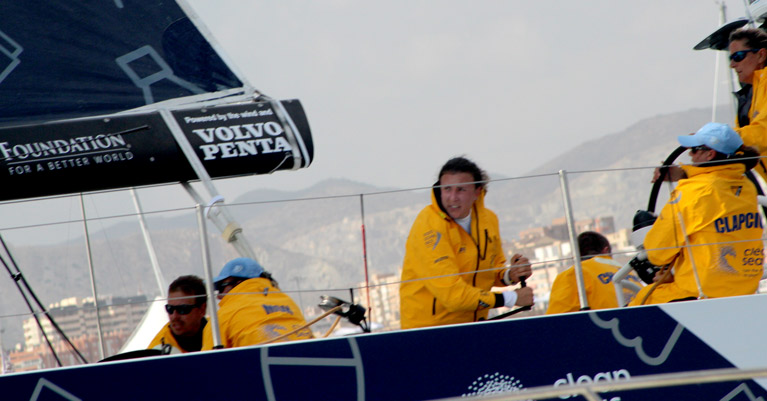 Annalise Murphy onboard Turn the Tide on Plastic shortly after the start Photo: Theo Lyttle
Annalise Murphy onboard Turn the Tide on Plastic shortly after the start Photo: Theo Lyttle
Annalise Murphy on Turn the Tide on Plastic is currently vying for fourth place with Dongfeng, Team Brunei, and Team Sung Hung Kai/Scallywag, while in third place is AkzoNobel.
Under present conditions, the second stage of Leg 1 from Porto Santo to Lisbon will be a tricky proposition, as winds are mostly light northeaster, though with the usual localised blast of easterly breeze coming through the Straits of Gibraltar.
Race tracker here
Ireland’s Damian Foxall Leads in Volvo Ocean Race
After their first night at sea, the seven boats in the Volvo Ocean Race are approaching the Straits of Gibraltar with Vestas 11th Hour Racing narrowly in the lead writes W M Nixon.
As a senior member of her crew is Ireland’s Damian Foxall, this rings bells at home. At the moment, however, our other star world racer, Annalise Murphy in Turn the Tide on Plastic, is towards the back, but it’s still a fairly close-packed fleet.
The Volvo Ocean 65s are in a rising easterly wind that will become a full-blown Levanter as they go through the Straits, and the course then takes a slight curve to port to carry them out to the island of Port Santo in the Madeira group. This provides the turning point to ensure they sail the required 1450 miles in the first leg to Lisbon in Portugal.
Race tracker here
Annalise Murphy Leads Irish Sailors Offshore in the Volvo Ocean Race & Middle Sea Race
There is a time and a season to all things, and in some years, that time comes earlier than others. Ireland has been getting away with it in remarkable style in recent weeks, putting through 2017’s Autumn sailing fixtures in between some bouts of very extreme weather. But this weekend, it looks as though we have to accept that you can’t beat the system all the time. The big winds of winter are here. The likelihood of sailing anywhere, and particularly in today’s Freshwater Keelboat Regatta on Lough Derg for Squibs, Dragons, SB20s and Flying Fifteens and the Autumn League final day at Howth Yacht Club, will probably have been discounted in the face of Storm Brian. W M Nixon looks south for sunshine and sailing.
If asked to rank the international sailing events of which come centre stage this weekend for their public interest, the lineup would be top place for the Volvo Ocean Race starting from Alicante tomorrow, the 608-mile Middle Sea Race which starts today from Valetta in Malta would be in second, third would be the 37th Annual Student Yachting Worlds among the Frioul Islands off Marseilles, which conclude tomorrow after five days of racing, while the biennial 690-mile Hong Kong to Vietnam Race which is currently finishing would come fourth.
The Volvo Ocean Race’s pre-eminence is inevitable. It’s a big razmatazz-filled long-running event which will carry us right through the winter and on into June 2018, when the seven contenders will have girdled the world by both the Cape of Good Hope and Cape Horn. They will fetch up to finish at The Hague in The Netherlands, right in the economic and political heart of the new Europe which may by then be emerging as Brexit takes shape, and the Volvo Ocean Race will make its own statement as representing a premier European brand of global status with dynamic Chinese connections.
However, before the proper show gets in the road tomorrow after the In-Harbour race this week, there have been the usual high dramas of a big-money event, with a relatively new Event CEO taking an early departure after his longterm plans proved to be a little too ambitious for the parent company, while one of the seven skippers was replaced in the week before the race because of a dispute about a budget over-run.
 Damian Foxall – a significant presence in any major international sailing event
Damian Foxall – a significant presence in any major international sailing event
As for Irish interest, we’ve learned through Afloat.ie of our people involved at many levels in both the overall administration and within the teams. But now that it’s down to the real thing, with the first leg getting under way tomorrow from Alicante in Spain round the Iberian peninsula and north to Lisbon in Portugal – a very interesting 1450 miles for racing – the focus is inevitably on the gladiators, the sailors on the Volvo 65 One-Designs, and especially on Ireland’s stars, Damian Foxall aboard Team Vestas and Annalise Murphy aboard Turn the Tide on Plastic.
Damian Foxall we know as part of world sailing’s essential structure. The boy from Derrynane has carved out an international role at the upper end of the really tough global events. We could spend the rest of this blog outlining his sailing achievements, and his increasing prominence in the environmental movement, but will content ourselves by saying that until Damian Foxall is somewhere in the lineup, any major ocean racing event lacks a certain credibility.
Annalise Murphy signs-up for Dee Caffari’s Turn the Tide on Plastic campaign? Well, that was sensational. The campaign is backed by a Portuguese-based foundation which at one stage owned the formerly-Irish Volvo Racer Green Dragon as the organisation developed its profile. But that became information which was only by-the-way as the full implication was realized of the new direction which had been taken in the life-path of Ireland’s winner of the Silver Medal in the 2016 Sailing Olympiad.
 The Volvo Ocean 65 Turn the Tide on Plastic - a very different sailing proposition to a Laser Radial or a foiling Moth, but Annalise Murphy is game for the challengeThose who devote themselves to the Olympic route to the exclusion of everything else inevitably seem a bit one-dimensional. But early in the season of 2017, Annalise, had already emphasised an interesting extra dimension by becoming the Women’s International Foiling Moth World Champion in the mega-fleet Moth Regatta in Lake Garda. And then when the big signing for Turn the Tide on Plastics was confirmed, we’d clearly moved on from a tunnel-vision Olympian to an all-rounder whose capacity as a very highly-trained athlete is uniquely allied with true sailing talent.
The Volvo Ocean 65 Turn the Tide on Plastic - a very different sailing proposition to a Laser Radial or a foiling Moth, but Annalise Murphy is game for the challengeThose who devote themselves to the Olympic route to the exclusion of everything else inevitably seem a bit one-dimensional. But early in the season of 2017, Annalise, had already emphasised an interesting extra dimension by becoming the Women’s International Foiling Moth World Champion in the mega-fleet Moth Regatta in Lake Garda. And then when the big signing for Turn the Tide on Plastics was confirmed, we’d clearly moved on from a tunnel-vision Olympian to an all-rounder whose capacity as a very highly-trained athlete is uniquely allied with true sailing talent.
It’s something which will certainly be tested to extremes in the weeks and months ahead, but for now the Volvo Ocean Race has seen much the most consistent build-up put in by the Spanish boat Mapfre, skippered by Xabi Fernandez. His CV includes an Olympic Gold Medal in the 49er and America’s Cup campaigns. While the Mapfre team were fourth in the previous Volvo, they showed real promise, and in 2017 they’ve been fastest out of the box, winning the very first encounter, their decidedly breezy race round the Isle of Wight in the midst of Cowes Week at the beginning of August.
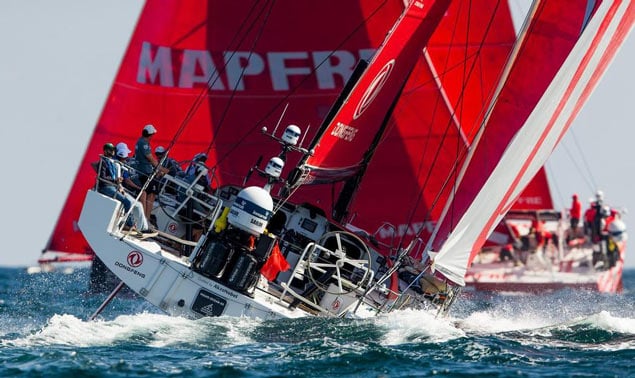 The Volvo Ocean 65 Mapfre on her way to winning the race off Alicante in perfect conditions, with Donfeng chasing on port tack
The Volvo Ocean 65 Mapfre on her way to winning the race off Alicante in perfect conditions, with Donfeng chasing on port tack
Their longtime lead in the Fastnet Race was snatched away at the last moment, but they’ve always been in the frame, and in this week’s In Harbour race – obligingly sponsored by their parent firm – it was Mapfre which took the bullet.
So we go into tomorrow’s Leg 1 with Mapfre already the boat to beat. But with a course which includes all the vagaries of the western Mediterranean, all the problems of the Straits of Gibraltar, and the decidedly intriguing passage from the Straits to Lisbon, we’re going to know a lot more about the Volvo Seven within a few days.
Meanwhile, in the almost ludicrously picturesque Grand Harbour in Valetta, tension is humming in the buildup to the start at 11:00 hrs CEST of the 39th Rolex Middle Sea Race this morning, at 608 miles one of the world’s 600-plus offshore classics. And it’s as tricky a course as you’ll find in many year’s racing, going from Malta anti-clockwise round various islands of which Sicily is the largest, and then back to Valetta.
Along the way you’ve to deal with obstacles such as the Straits of Messina while becoming accustomed to seeing active volcanoes as part of the view. And as for the winds, they can be all over the place, and sometimes astonishingly savage.
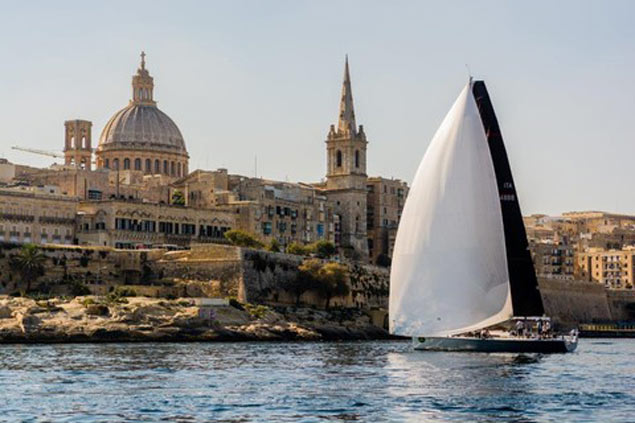 The Cookson 50 Endlessgame glides along off Valetta, on her way to winning Wednesday’s coastal race from 33 of the Rolex Middle Sea Race’s 110 contenders.
The Cookson 50 Endlessgame glides along off Valetta, on her way to winning Wednesday’s coastal race from 33 of the Rolex Middle Sea Race’s 110 contenders.
Irish Sea connections go all the way back to the first race of 1968, when Solly Parker, who based his hefty Sparkman & Stephens 40ft sloop Deb in Holyhead, was persuaded by offshore racing stalwarts such as Dickie Richardson and Alan Stead that this new race was a must-do - Deb should be in it for the honour of the Irish Sea.
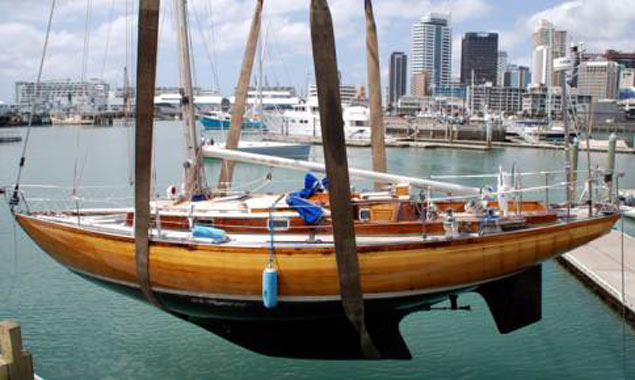 Tom & Vicky Jackson’s famous Sunstone reveals herself. New-built by McGruer of Scotland as Deb in 1965, she was one of Sparkman & Stephens first fin-and-skeg designs, and sailed in the first Middle Sea race of 1968. Throughout the 1970s, she was a regular ISORA participant under the name of Dai Mouse III
Tom & Vicky Jackson’s famous Sunstone reveals herself. New-built by McGruer of Scotland as Deb in 1965, she was one of Sparkman & Stephens first fin-and-skeg designs, and sailed in the first Middle Sea race of 1968. Throughout the 1970s, she was a regular ISORA participant under the name of Dai Mouse III
The logistics of getting her there and back scarcely bear thinking about, and her showing was only very middling. For although Deb could maintain a very good average speed in steady conditions – she is now Tom & Vicky Jackson’s Sunstone, arguably the most famous wooden cruising yacht in the word – the Middle Sea Race tends to favour boats which can accelerate quickly, and attain colossal speeds when conditions are right.
Since the Great Deb Expedition, the Rolex Middle Sea Race has always been of interest to Irish and Irish Sea sailors, and we’re on a roll with it these days, as Ian Moore navigated the 2016 overall winner, the Cookson 50 Mascalzone Latino, while in 2015 father-and-son crew Dermot and Paddy Cronin from Malahide won the two-handed division with their First 40.7 Encore, which was simply a sensational performance - there’s no other word for it.
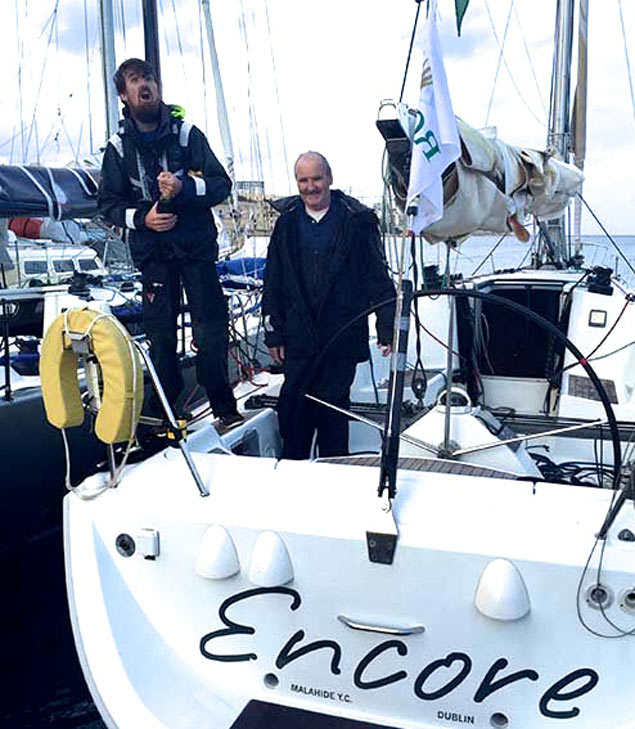 Sensational! Paddy & Dermot Cronin of Malahide after winning the two-Handed Division in the 2015 Rolex Middle Sea Race.
Sensational! Paddy & Dermot Cronin of Malahide after winning the two-Handed Division in the 2015 Rolex Middle Sea Race.
The 110-strong fleet this year is as usual very eclectic, and exceptionally international with entries from Australia, New Zealand, the US, Chile, Lithuania and just about everywhere else you care to name, including countries which the rest of the world might think of as being involved in low key wars with each other, such as Russia and the Ukraine.
But then when you remember that ISORA was never more active than when the Troubles were at their height in the 1970s, then maybe offshore racing’s role in preserving civilised values in times of turmoil is something deserving of deeper examination. For although the competition may be fierce, there’s no greater symbol of peace than a racing yacht going about her harmless business.
With such a fleet, prediction is a real gamble, particularly as it’s expected to be light winds at first, with a fresher nor’wester spreading in on Monday. That looks to favour smaller craft, but as suggested, this is a race which is good for boats which accelerate rapidly and are capable of exceptional speeds, so the fact that George David’s Round Ireland Record-holding Rambler 88 is on the starting blocks is worthy of note.
 Among the favourites for the Two-Handed Division are Sean Arrigo of Malta and Brian Flahive of Wicklow
Among the favourites for the Two-Handed Division are Sean Arrigo of Malta and Brian Flahive of Wicklow
2016 champion Mascalzone Latino is away doing the Hong Kong to Vietnam Race with Ian Moore as navigator in the buildup to the Sydney-Hobart 2017 in December, and at time of writing she was leading IRC overall, so back in Malta it may well be that our best hope is in the two-handed division, where the hugely-experienced and successful Brian Flahive of Wicklow has teamed up with Sean Arrigo to race the J/122 Otra Vez. She’s a boat regularly in the frame in the Middle Sea race, and is the two-handed favourite.
In terms of glamour attention, the focus is on the IMOCA 60 Hugo Boss, with Alex Thomson and Nin O’Leary of Cork co-skippering. Mixed messages have been circulating about her crewing arrangements, and the best word we have is she’ll be doing it with four, as the two boyos will be joined by Will Jackson and Jack Trigger. There’ll be just those two extra, as there simply isn’t room for any more in that very focused little cockpit.
In a vid interview with The Times of Malta earlier this week, you gained the impression that Alex was doing the Middle Sea Race single-handed, but this more recent posting tells us Nin is definitely there:
Getting the very purpose-designed Vendee Globe racer Hugo Boss out of the narrow waters of Grand Harbour is going to be a bit of a challenge in itself. And as for competing in the quirky and often restricting Middle Sea Race in a vehicle which is at her magnificent best tearing along off the wind in the wide open spaces of the Great Southern Ocean, well, under any Horses for Courses Protocol, the Middle Sea Race might well come under Cruelty to Animals regulations……..
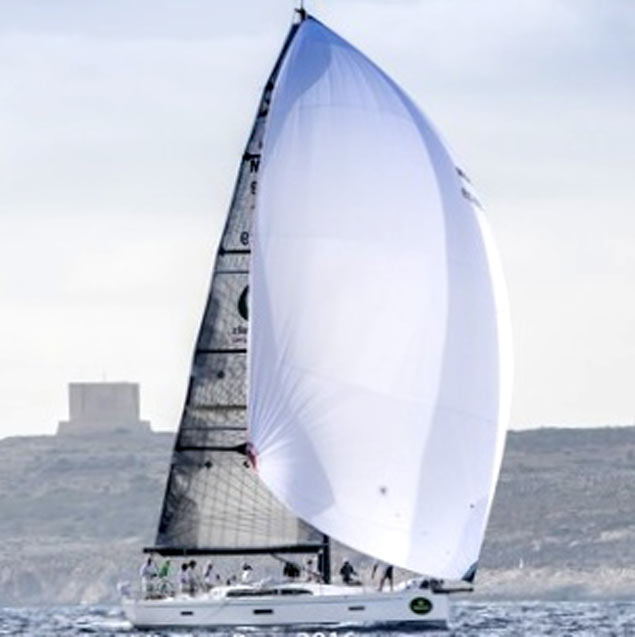 Wolf in sheep’s clothing…..the Xp44 Xp-Act has a strong Irish presence, and a successful race record
Wolf in sheep’s clothing…..the Xp44 Xp-Act has a strong Irish presence, and a successful race record
But we’ll be delighted to be proven very wrong. In another area of the fleet entirely, we have the reliable solidity of Barry Hurley, doing his fourteenth Middle Sea Race, and building on past successes by staying with the surprisingly quick “performance cruiser” Xp44 Xp-Act, owned by Joseff Schultels who co-skippers with Timmy Camilleri. They’ve lined up formidable talent with a strong Irish flavour, as it includes Barry Hurley (originally of Cobh) and Shane Diviney (Howth) as well as the exceptional international talent of Jochem Visser of Fastnet 2007 fame, and there’s a link to Round Irelands too, as Carlo Vroon of Tonnerre is on Xp-Act’s strength, while the former Round Ireland star, the Ker 46 Tonnerre de Breskens, is in this race, now known as Tonnere de Glen, and French-owned.
Also French-owned, but of special interest to Irish offshore aficionados, is the new Teasing Machine III for the ever-enthusiastic Eric de Turckheim of La Rochelle. A Nivelt-Muratet 54, she was launched from builders King Marine in Spain on July 6th, but seemingly there just wasn’t the time to get her completely race-ready for the Fastnet in August, so this morning will see her debut on the big stage.
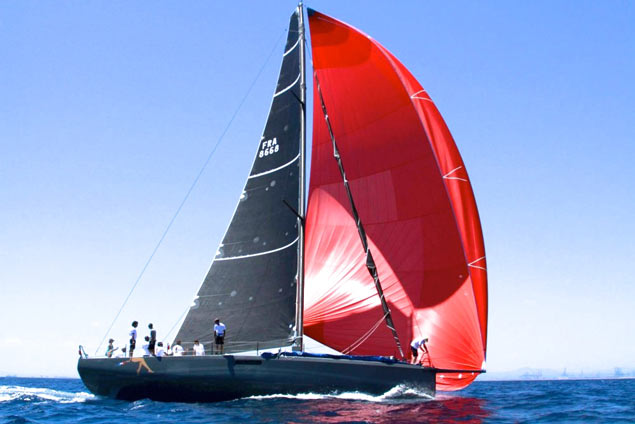 The new Teasing Machine III, a Nivelt Murat 54, was launched in July
The new Teasing Machine III, a Nivelt Murat 54, was launched in July
As for that remarkable wolf-in-sheep’s-clothing, the Xp44, we’ve additional interest here as ISORA’s Andrew Hall has chartered another of them, X-Prime. Indeed, charter is a strong theme this year, as Conor Doyle of Kinsale is into the fray with a Kinsale YC crew and the chartered DK 46 Hydra, a Mark Mills design of 2004 vintage.
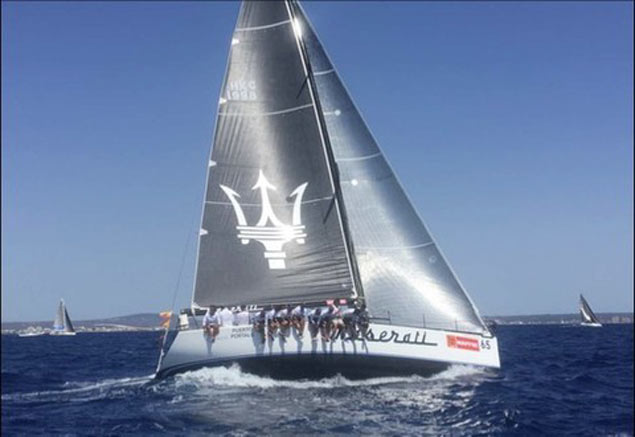 Conor Doyle of Kinsale has chartered the Mark Mills-designed DK46 Hydra
Conor Doyle of Kinsale has chartered the Mark Mills-designed DK46 Hydra
For Irish crews chartering, it’s a very accessible event just when you need a dose of sunshine to face the winter. But the Middle Sea Race has an almost mythical appeal which draws them in from all round the world, with Australia represented by Ludde Ingvall’s extraordinary hyper-skinny maxi CQS, which is so narrow that she has to carry her shrouds on a modern version of the channels required by the old “plank-on-edge” gaff cutters. In fact, CQS looks for all the world like one hull of a catamaran with an enormous keel under it, and for the life of me I just can’t see the concept working.
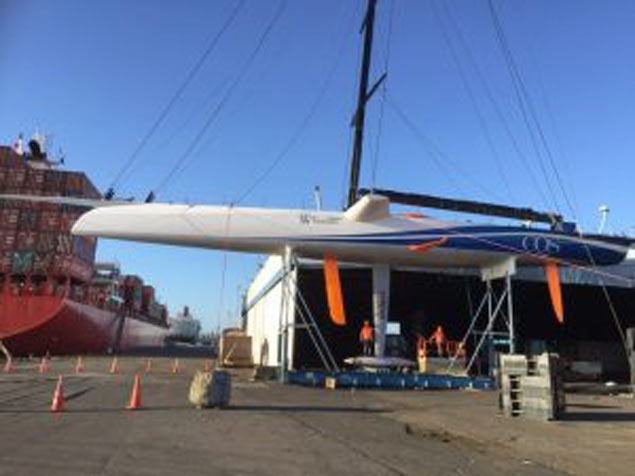 The 100ft CQS – she looks for all the world like one hull of a catamaran with an enormous keel attached
The 100ft CQS – she looks for all the world like one hull of a catamaran with an enormous keel attached
More conservative yet capable of real speed at the top of the fleet is the 100ft Leopard, entered by Pascal Oddo of France, whose main purpose will be to finish ahead of Rambler. Rambler in turn may find herself nibbled at by some Maxi 72s, notably Dieter Schon’s Momo from Germany and George Sakellaris’s Proteus from the US.
With Cookson 50s still giving everyone a hard time, the presence of two of them will always have to be considered, and one of them – Endlessgame (Pietro Moschini) – has already put up a marker by winning the coastal race on Wednesday against 33 other boats.
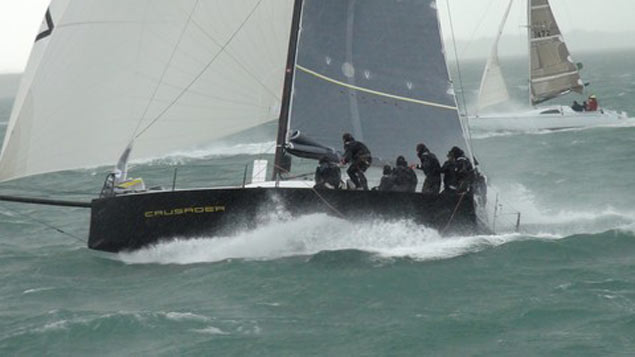 She looks like a lot of fun – the Elliott 35 Crusader from New Zealand burning it off
She looks like a lot of fun – the Elliott 35 Crusader from New Zealand burning it off
As for the far travellers, New Zealand’s representative is the sporty 2012-built Elliott 35 Crusader, which looks like a lot of fun and is being skippered by Brett Elliott for owner Anthony Leigh. The Chilean entry Anita (Nicola Ibanez Scott) is a J/122 whose home club is listed as Puerto Williams YC. Puerto Williams is often the final port of call before departing for Antarctica. It’s not often you see an RORC entry list with PWYC named as home club, so we’ll keep a specially benign eye on Anita’s progress.
But as to the overall winner, it’s all wonderfully open. Maybe as much as a quarter of the fleet are in with a good chance. Now that really is sport.
 Shades of Shackleton - the J/122 Anita from Chile gives her home club as Puerto Williams YC
Shades of Shackleton - the J/122 Anita from Chile gives her home club as Puerto Williams YC
Moving on to Item 3 on our Agenda of Interest, the islands of he Frioul Archipelago off Marseilles where the Student Yachting Worlds are entering their finals stages are about as different in atmosphere as possible from Puerto Williams. But sailing is sailing the world over.
And after all, it was in the Student Yachting Worlds of 2008 that one Nicholas O’Leary of Cork Institute of Technology won this championship overall by 0.9 points and had his first taste of international fame. So maybe the current UCD team of all the talents skippered by Jack Higgins can continue their progress up the leaderboard and provide us all with good news tomorrow.
Finally, it looks as though Ian Moore and Mascalzone Latino have it in the bag for the IRC overall win in the Hong Kong to Vietnam Race. So what’s the big deal in a race with only 13 boats, even if it does entitle ML’s crew to go in the Sydney-Hobart? Well the fact that an offshore race is finishing in a country that seemed a hopelessly war-torn zone no so very long ago is important. But equally, China – Napoleon’s “sleeping giant” – is very much awake. And sailing, like everything else, will be hearing a lot more about China.
Mark Turner Video on Quitting the Volvo Ocean Race
Volvo Ocean Race CEO Mark Turner has spoken out about last month's decision to leave the race just weeks before it starts in Alicante. Turner also talks in the video below about how the proposed 2019-20 Volvo Ocean Race in new boats would not now take place.
In a video (released through the Volvo Ocean Race), Turner admits that he essentially failed to get signatures on the dotted line in time to be able to move forward with racing in new boats for 2019-20.
See the video below:
Mark Turner Steps Down as Volvo Ocean Race CEO, Volvo Reconsiders Future Schedule as 2019 Race Start Ruled Out
Following discussions with key Volvo Ocean Race stakeholders it has been determined that 'additional planning time' is required to implement the recently announced changes to the race schedule. As a result, the proposed 2019-20 race in new boats will not take place as planned. A revised schedule for future Volvo Ocean Races will be announced as soon as possible. Volvo remains committed to ensuring that any planned changes deliver long-term sustainable benefits to the race and participating teams.
The design work on the exciting new Super 60 concept, at the forefront of foiling offshore monohull technology, continues.
The current 2017-18 Volvo Ocean Race is completely unaffected by this change and will proceed as publicly announced.
As a consequence of this review to the race schedule the current CEO for the race Mark Turner has decided to step down from his current position. He will remain in the CEO role until a successor is appointed, a search for which has started.
“Whilst we regret the fact that Mark has decided to step down from his current role, we are grateful for the hard work and contribution over the last 16 months. The leadership team Mark has put in place will ensure the race remains both a world class sailing and business platform and we wish him all the best for the future,” says Henry Stenson, Chairman of the Volvo Ocean Race supervisory board.
“Although I have decided to step down from my position, I am very grateful to have had the opportunity to lead the Volvo Ocean Race at this important time. I am confident the 2017-18 race will be one of the best ever,” says Mark Turner.
Volvo Ocean Race ready for start of race in October 2017
The 2017-18 Volvo Ocean Race will start in Alicante on October 22, 2017 and finish in The Hague in June 2018, visiting 12 stopovers (Alicante, Lisbon, Cape Town, Melbourne, Hong Kong, Guangzhou, Auckland, Itajaí, Newport, Cardiff, Gothenburg, The Hague) in the epic around the world adventure covering 45,000 nautical miles. The race will be made up of 7 highly qualified and professional sailing teams, including some of world’s most accomplished and experienced sailors.
The teams are: Team AkzoNobel, Dongfeng Race Team, MAPFRE, Vestas 11th Hour Racing, Sun Hung Kai/Scallywag, Turn The Tide on Plastic and Team Brunel.
Q&A
Q: Will there be an impact on the 2017-18 Volvo Ocean Race?
A: No impact on the current edition of the race is expected. Mark Turner’s role was primarily focused on future strategy. The Leadership Team is very well prepared and ready to deliver an outstanding sporting and sponsorship experience. Mark Turner will remain as CEO until a successor is appointed.
Q: It was announced in May that future races would be held in a two year cycle, rather than the current three year cycle, has that changed?
A: AB Volvo and Volvo Cars are committed to developing the race going forward as announced in May, including optimising the race cycle. However, following discussions between the two owners of the event, it has been determined that in order to fully implement the announced changes additional planning time is required, specifically in relation to the race cycle. A final decision will follow at a later stage.
Q: It was recently announced that the next Race would start in 2019, is that still the case?
A: Following discussions between Volvo companies, it has been determined that in order to fully implement the announced changes additional planning time is required, specifically in relation to the race cycle. A final decision on this will follow at a later stage. This rules out a race start in 2019 with new boats, however the Volvo Ocean Race leadership team is developing plans to ensure activation opportunities and stakeholder return using the existing boats.
Q: A number of additional initiatives were announced in May aimed at developing the sporting and commercial value further, are these other initiatives still going ahead?
A: Yes, that is the intention.
The Clipper Round the World Yacht Race and the Volvo Ocean Race, found themselves as neighbours for the first time this week berthed in Gosport, UK at exciting milestones in their event countdowns.
The Clipper Race, the only event on the planet which trains non-professionals to become ocean racers, is preparing to leave for Liverpool for the 2017-18 race start; whilst the professional Volvo Ocean Race teams are competing in Leg Zero which includes the Rolex Fastnet Race starting this Sunday (6 August), effectively a qualifying leg for the 2017-18 edition that starts from Alicante, Spain on 22 October, 2017.
Sir Robin Knox-Johnston, the first man to sail solo, non-stop around the world in 1968-69, and a veteran of the Whitbread Round The World Race (now known as the Volvo Ocean Race), who established the Clipper Race over twenty years ago, commented: “There’s been a great buzz around the marina all week and I think as much as the Clipper Race crew are feeling rather excited to be so close to their professional counterparts, I have also been impressed by the respect shown by the Volvo Ocean Race sailors towards our crew.
“Oceans do not distinguish between professional or non-professional sailors. The many challenges of racing around world are huge and the determination and endurance required to succeed is to be admired. Full respect to anybody, whether in the Clipper Race or Volvo Ocean Race, who takes on this unique challenge."
Approximately 40% of Clipper Race crew, who come from all walks of life and different careers, have no previous sailing experience when they first sign up. Four intensive weeks of training are provided to prepare crew, and each of the twelve teams is led by a professional Skipper.
Dee Caffari MBE is competing in her second consecutive Volvo Ocean Race, skippering the ‘Turn the Tide on Plastics’ team, having competed on Team SCA in 2014-15. Dee, who has also been a Clipper Race Training Skipper in the past, says: “It is commonly stated that more people have ventured into space or have climbed Mount Everest than have sailed round the world, so anyone who takes on the challenge of circumnavigation should be highly respected.
“Experiencing the remotest and harshest parts of our planet in such a thrilling environment is something that bonds ocean sailors together and forever unites us as family. Sir Robin and the Clipper Race has been resolute in making this opportunity available to an ever-increasing number of people over the years, which is only positive for the future growth of our sport.
“It’s been a pleasure to see the Clipper Race crew busy preparing this week. I wish them all the best for their upcoming journey and look forward to sharing the unique and inexplicable bond of circumnavigation with them upon their return.”
Since the Clipper Race started over twenty years ago almost 5,000 people have been turned into ocean racers. Crew members can choose to compete in individual race legs or the entire challenge. This is where everyone from chief executives to taxi drivers, nurses and firefighters, farmers, airline pilots and students, from age 18 upwards, join together to compete. There is no upper age limit, the oldest competitor to date is 74.
Pip O’Sullivan, 29, from Hampshire, left her job in Marketing recently and will be circumnavigating on board the GREAT Britain Clipper Race team. Before starting her training she had no previous sailing experience.
Pip says: “I’ve known about the Volvo Ocean Race for a long time but I never knew it would be possible that a non-sailor like myself could train and take part in a challenge of that scale, until I heard about the Clipper Race through a crew member who took part in the previous edition. I was looking for a big challenge and wanted to learn a new skill so it was the right time to make such a life-changing decision.
“Now, we’re here in the same marina as the Volvo Ocean Race sailors, preparing for our own races. Our challenges are very different, they are professional sailors, but the fact everyday people like me have the opportunity to experience such a challenging feat, is pretty special. Not long to go now, and we all just can’t wait to get started.”
The Clipper 2017-18 Race starts August 20 from Liverpool’s Albert Dock and will return eleven months later on July 28, 2018 after racing 40,000 nautical miles in 13 races across six continents. A total 712 crew members will compete on board twelve teams, representing 41 different nationalities.
The Volvo Ocean Race 2017-18 edition starts 22 October 2017 from Alicante, Spain and will take the teams 45,000 nautical miles around the world – across four oceans, touching six continents and 12 Host Cities, and finishing at the end of June 2018 in The Hague.
Olympic Champion Blair Tuke Joins MAPFRE in Volvo Ocean Race
New Zealand’s Blair Tuke is joining MAPFRE in the Volvo Ocean Race in 2017-18, and could become the first sailor in history to win the ‘Triple Crown’ of an Olympic gold medal, the America’s Cup and the Volvo Ocean Race. At least, that's how VOR organsiers are calling it, and in so doing proclaiming the ocean race equal to the Olympics and the America's Cup.
At the age of just 27, the Kiwi is already one of the most decorated sailors in the world – and joins the Spanish campaign fresh from New Zealand’s victory in the America’s Cup last month and an Olympic gold medal in 2016.
Tuke, who has also won four consecutive 49er World Championships and was named ISAF Sailor of the Year in 2015, links up with MAPFRE skipper Xabi Fernández to take on the ultimate test of a team in professional sport – a 45,000 nautical mile race around the planet.
“The idea of doing the Volvo Ocean Race is something I’ve been very excited about ever since I was a little kid. Everyone closest to me has known I’ve wanted to do this race for so long, even before I did the America’s Cup and the Olympics. I’m so happy to finally have the opportunity – and to do it with MAPFRE is something I’m really looking forward to,” said Tuke.
“I’ve raced with Xabi a lot in the 49ers and when the race came to Auckland in the 2014-15 edition, I went onboard MAPFRE for the In-Port Race and the start, so I’ve seen them in action close up. The team has a lot of really good guys on the boat and I think it’s a great opportunity for me. I’m really happy to be teaming up with MAPFRE.”
The race will be Tuke’s first competitive foray offshore, and with the One Design Volvo Ocean 65 boats set to race three times more Southern Ocean miles than in recent editions, it promises to be a steep learning curve.
“I’m under no illusions as to the learning curve I’ve got in front of me – I know what it’s like to be out there and offshore, but to do it at this high level of a race is going to be new to me,” continued Tuke.
“The thought of racing into Auckland, and then leaving again for the Southern Ocean, is pretty exciting, but before I get there I have to do a lot of learning, and gain more experience in how to make these boats go fast.
“I’m excited for the challenge – I’ve loved being challenged in the past, and having to learn fast, and I’m really looking forward to this one.”
Securing his spot in the Volvo Ocean Race caps an unforgettable 12 months for Tuke, who scooped an Olympic gold in the 49er class at Rio 2016 alongside his long-term sailing partner Peter Burling.
The pair took first place with two races to spare, boasting a 43-point margin over their nearest challengers – the biggest gap in any sailing class since modern scoring began – to add to a silver medal achieved at London 2012.
Burling and Tuke then played an integral part in Emirates Team New Zealand successful America’s Cup campaign, winning them a second major trophy in less than a year.
“It’s awesome to see how the whole country gets behind the Volvo Ocean Race. It’s got the Kiwis’ hearts just because of the incredible history in the race. It’s a great time to be heading to there – the reception that we’ve just received with Emirates Team New Zealand shows just what top-level sailing means to people across the country.
“Seeing all the boats out there in the harbour as we took the Cup out and did a little tour was really cool, and it’s the kind of thing you only usually see when the Volvo Ocean Race comes into town, or when the Cup was in New Zealand last time. Sailing is very much on the map and it’s going to be an incredible Volvo Ocean Race stopover in 2018.”
Since 1973, winning the Volvo Ocean Race has been an obsession for the world’s best sailors, desperate to prove that they have what it takes to claim glory in the pinnacle of offshore sailing.
MAPFRE skipper Xabi, who also boasts an Olympic gold and silver medal, has spent the last decade chasing victory in the Volvo Ocean Race – and has packed his squad with highly-experienced and decorated sailors ahead of the 2017-18 edition.
“Blair is a really exciting sailor for the team,” explained Fernández. “Nobody can doubt his talent, and I am absolutely convinced that he will be a really strong addition to the team as trimmer and helmsman.”
“We first met Blair in 2010, when we raced against Peter Burling and Blair in the last World Championships we participated in. Then, in 2012, when we were in Auckland with the Volvo Ocean Race, we trained with them in a 49er on our rest days preparing for the London Olympic Games,” explained Fernández.
“In 2014-15, he joined us on MAPFRE sailing in a ProAm, and on the start day he was our ‘jumper’ for the leg start – and he told us then that he wanted to one day take part in the Volvo Ocean Race."
Pedro Campos, CEO of the team, said: "It's excellent news that Blair has joined us – there is no doubt that he is one of the great names of our sport at the moment. The fact that he has accepted our invitation to join the team make us proud and demonstrates the international prestige that MAPFRE holds across the world. If we could win this edition of the Volvo Ocean Race, Blair would become the first sailor in history to achieve the 'Triple Crown': Olympic gold, the America's Cup and the Volvo Ocean Race, which will generate strong international media coverage of our team."
MAPFRE will be joined on the start line by Dongfeng Race Team (skippered by Charles Caudrelier), team AkzoNobel (Simeon Tienpont), Vestas 11th Hour Racing (Charlie Enright), Team Sun Hung Kai/Scallywag (David Witt), Turn the Tide on Plastic (Dee Caffari) and Team Brunel (Bouwe Bekking). The race departs from Alicante on 22 October 2017.
The race takes in a total of 12 Host Cities around the world, finishing in The Hague at the end of June 2018.
Despite some interruptions from either too much or too little wind, the regular club sailing programme for 2017 is now fully under way, and this weekend is additionally so well filled with major regional and national events that you could be forgiven for thinking it’s high summer already. W M Nixon tries to make sense of it all.
How on earth is anyone expected to fully understand, let alone explain, a global activity which today sees the extraordinary 1,500 boat Festival of Sail in the Morbihan in France putting in its final races and fleet manoeuvres, before everyone joins in the end-of-show Parade of Sail tomorrow?
Yet at the same time, across the Atlantic in Bermuda, the first moves in the 35th edition of the America’s Cup, arguably the world’s oldest international sporting contest as it goes back to 1851, are getting under way, involving sailing machines for which the word “boat” seems somewhat inappropriate.
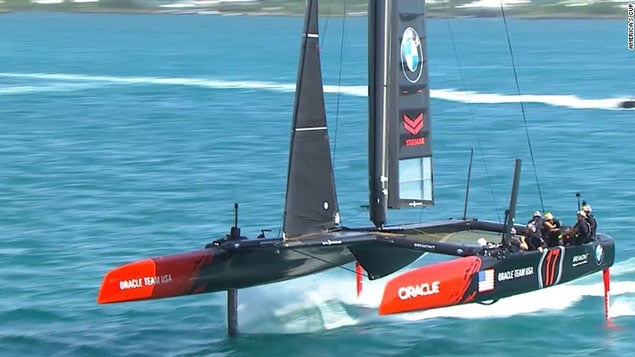 It’s difficult to think of them as anything other than “sailing machines,” but America’s Cup rules reckon they are boats
It’s difficult to think of them as anything other than “sailing machines,” but America’s Cup rules reckon they are boats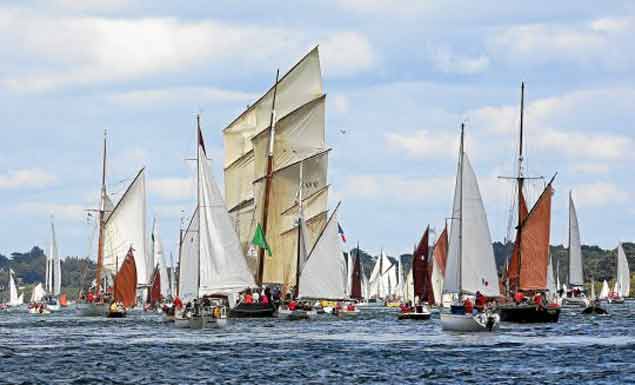 Some of the huge fleet at the current Morbihan festival. In their midst is the bisquine-rigged La Cancalaise from Cancale. In the days of piracy, smuggling and privateering in the English Channel, it was reckoned that any vessel setting this demanding high-performance rig was up to no good, and therefore a legitimate target for government ships
Some of the huge fleet at the current Morbihan festival. In their midst is the bisquine-rigged La Cancalaise from Cancale. In the days of piracy, smuggling and privateering in the English Channel, it was reckoned that any vessel setting this demanding high-performance rig was up to no good, and therefore a legitimate target for government ships
Then too, the world sailing community is still digesting the revelation that future generations of boats in the Volvo World Race, which now rivals the America’s Cup for international attention, will be in effect IMOCA 60s with mega-foils.
And in addition to that, at each in-harbour stopover, the world-girdling Volvo Ocean Race crews will be expected to do a series of races in smaller but very potent multi-hulls which will thrill spectators with their closeness to the watching crowds and to each other, with hair’s breadth misses – and ideally the occasional not-too-serious shunt - a central part of the action.
All these major international events then have to be fitted around the reality that, like it or not, sailing is one of those minority sports that need the Olympics more than the Olympics need sailing. In other words, we have to keep the decks clear of other major international fixtures to give total attention when the next sailing Olympiad at Tokyo comes along in 2020.
For those who would snort in derision at such a suggestion, do tell us what you were doing (if you can remember) while the rest of Ireland held its breath and watched as Annalise Murphy was sailing towards her Silver Medal on August 16th 2016?
Nevertheless, having taken all that into account, the reality is that the top end of sailing is reaching ever-higher peaks of performance in everything, and inevitably using boats and equipment of unimaginable expense. So except for the Morbihan event - whose ethos is found in going the other way, with total democratic involvement for everyone - how on earth can ordinary sailors relate to what the participants in the America’s Cup and the Volvo World Race are experiencing?
Let’s be honest. We can only do so - if at all - with some mighty leaps of the imagination. The result is that many of us are going back to the knitting. We’re going back to trusted events, and staying with sailing boats which may not be in the first flush of youth, but at least they mean something to us.
We know that with them, we can find racing which bears some relation to everyday life rather than the other-world dreamscape which is the America’s Cup or the Volvo World Race.
Over the next two weekends in Ireland, this racing of familiar boats will move up a couple of gears, as this weekend is the Bank Holiday in the North, and in a week’s time the extra day off is in the Republic. So keen sailors who see their programme on an all-Ireland basis somehow manage to convince themselves that we have two all-island Bank Holidays on the trot.
 Galway hookers gather at the Claddagh, while above them is the Galway City Museum, currently staging a Marine Science Exhibition.
Galway hookers gather at the Claddagh, while above them is the Galway City Museum, currently staging a Marine Science Exhibition.
Thus the ongoing Claddagh Festival with all varieties of Galway Hookers on show in the City of the Tribes is also managing to welcome Viking longships which have been brought overland from their home port of Ardglass in County Down. And at least the northerners have the proper claim that, for them, Monday is a free day to get their boats home again.
That equally applies to northern visitors to the Woodenboat Festival in Baltimore, which got going last night and should have good weather from midday onwards today, and through tomorrow’s colourful programme. Nevertheless for those with a day job to think about, the long haul home on Sunday night can become very long indeed.
 Baltimore in West Cork - the perfect location for a friendly Woodenboat Festival
Baltimore in West Cork - the perfect location for a friendly Woodenboat Festival
 It’s not quite racing, but when a Galway hooker (left) finds competition at Baltimore Woodenboat Festival with a traditional West Cork boat, there’s certainly an added edge to the sailing. Photo Sheena Jolley
It’s not quite racing, but when a Galway hooker (left) finds competition at Baltimore Woodenboat Festival with a traditional West Cork boat, there’s certainly an added edge to the sailing. Photo Sheena Jolley
Both these events are traditional annual festivals in which racing plays only a small – if any – part. But even in competitive sailing, all the signs are that people are returning to beef up the numbers and competition in events which served them well in the past, yet had slipped in the popularity ratings owing to a change in behavioural patterns (the modern family is an extremely demanding taskmaster), and the ill-effects of the economic recession.
Everyone has been heartened by the new strength of the Irish Sea Offshore Racing Association (to which we’ll return in a minute), but today the top of the agenda is the Scottish Series, getting up to speed at the lovely little port of Tarbert on Loch Fyne. Of course, numbers are nothing like the eventually unmanageable crowd of boats which became a feature of this series about twenty years ago. But nevertheless there’s a tidy fleet at Tarbert, and a strong Irish contingent are in with more than shout of bringing home the big prize.
 Packing them in – the Scottish Series fleet in Tarbert
Packing them in – the Scottish Series fleet in Tarbert
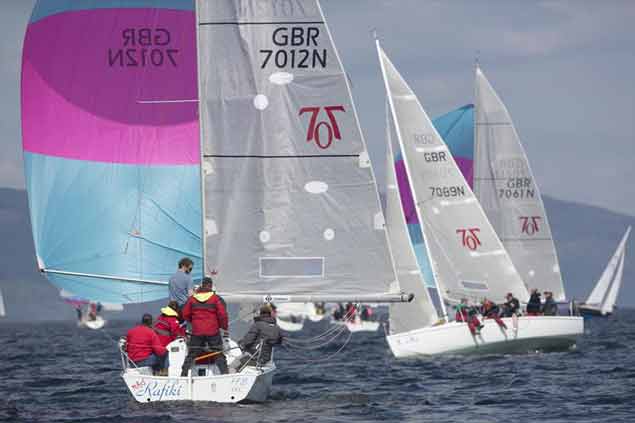 The Hunter 707 fleet provided some of the best racing at last year’s Scottish Series
The Hunter 707 fleet provided some of the best racing at last year’s Scottish Series
 Dara O’Malley (second left) and his winning crew on Seaword, which made him Afloat.ie “Sailor of the Month” for May 2016. Photo: Marc Turner
Dara O’Malley (second left) and his winning crew on Seaword, which made him Afloat.ie “Sailor of the Month” for May 2016. Photo: Marc Turner
Last year it was one of the diaspora, Dara O’Malley originally from Westport but now sailing on the Firth of Forth with his Hunter 707 Seaword, who was tops. While he may be Scottish-based, he was home among us in January to receive his Afloat.ie “Sailor of the Month” Award for May 2016 at the National Sailing Awards in the RDS.
He is defending this weekend, and another former overall winner is the irrepressible Rob McConnell from Dunmore East. With an almost entirely Waterford Harbour SC crew, Rob’s A35 Fool’s Gold is reportedly in particular good trim this year, so definitely a boat to watch.
Other strong performers from Ireland over in Tarbert include the Kelly family from Rush with their J/109 Storm, and that highly individualistic helmsman renowned for pulling rabbits out of the hat, Johnny Swan with his classic Half Tonner Harmony from Howth. Strangford Lough is sending the notably steady perfomer Jay Colville with his successful First 40 Forty Licks, while all the way from Cork Harbour is the First 36.7 Altair (K Dorgan & J Losty) of Cove Sailing Club, recalling the enthusiasm of a high order which used to be a feature of the O’Leary family’s years with the Corby 36 Antix from Crosshaven, an overall winner in Scotland on more than one occasion.
 They might do it again......Rob McConnell (fourth left) and his mostly Dunmore East crew after winning the Scottish Series in 2015 on the Archambault 35 Fool’s Gold. Photo: Marc Turner
They might do it again......Rob McConnell (fourth left) and his mostly Dunmore East crew after winning the Scottish Series in 2015 on the Archambault 35 Fool’s Gold. Photo: Marc Turner
The continuing growth of the J/109s, which have needed ten years to become an overnight success in Ireland, is shown by the additional presence in Scotland of two of Storm’s sister-ships from home, Andrew Craig’s Chimaera and John & Brian Hall’s Something Else, while a smaller manifestation of the J Boat range’s ubiquitous nature is the participation of Stephen Quinn’s J/97 Lambay Rules from Howth.
It’s an interesting crew setup, as Lambay Rules’ core team, including Stephen Quinn himself, have been seen racing in the elegance of Stephen O’Flaherty’s Spirit 54 Soufriere, whose claims to fame include a role in a James Bond movie. Despite the obvious differences between the two boats, the key personnel – including Stephen O’Flaherty – moved aboard the little Lambay Rules for last year’s Volvo Round Ireland Race, and despite being one of the smallest boats in the fleet (in fact, I think she was the smallest), at several stages they were leading their class, but not alas at the finish.
Their determined involvement in Scotland says much for their continuing zest in the game, but meanwhile back home the presence of so many significant boats over in Scotland has done little to diminish numbers for this morning’s ISORA Race from Dun Laoghaire to Arklow, which will see 28 starters.
PHOTO HERE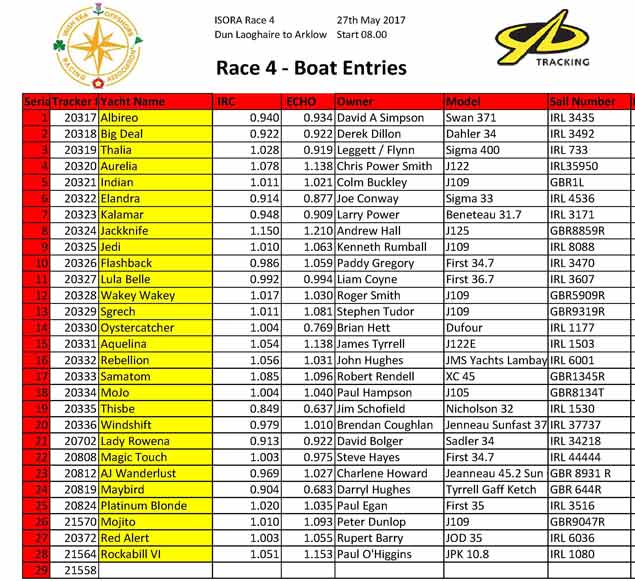 The lineup for today’s ISORA-Dun Laoghaire Race
The lineup for today’s ISORA-Dun Laoghaire Race
Very senior ISORA contenders have a feeling that they must have raced to Arklow before, but maybe they’re confusing it with ISORA races which took in the Arklow Lightvessel as a mark of the course, and it’s undoubtedly a very long time since a lightship was on the Arklow Bank.
Certainly ISORA Chairman Peter Ryan says that this is the first time an ISORA Race has finished in Arklow, where the local sailing club has been expanding in a healthy style, while on the bigger canvas, the Tyrrell family with their succession of ever-larger and successful craft in the J Boat range – all called Aquelina – has done much to have Arklow SC punching way above its weight on the national offshore racing scene.
The Tyrrells were too far ahead of the curve when they got their first Aquelina, a J/109, shortly after the new marque was introduced. Their hopes of getting a semi-One-Design J/109 class going didn’t take off. But today, racing their current J/122E Aquelina back to their home port, they’ll ruefully observe that there are at least five J/109s racing with them, a goodly number when we remember that three of the Dublin class are in Scotland, and several others are staying in Dun Laoghaire to do today’s Dublin Bay SC race.
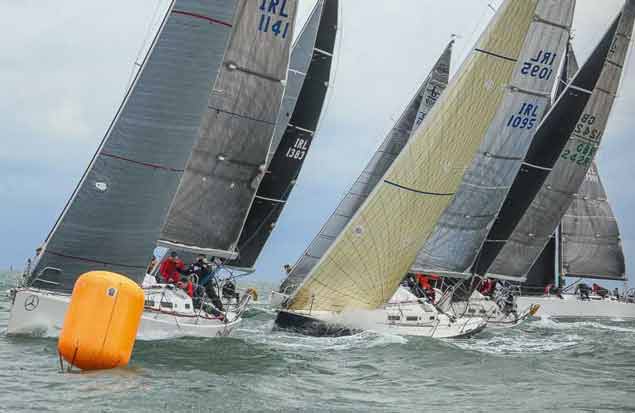 It has taken them ten years to become an overnight success, but the J/109s are now a very significant presence in Dublin Bay. Photo: Afloat.ie
It has taken them ten years to become an overnight success, but the J/109s are now a very significant presence in Dublin Bay. Photo: Afloat.ie
However, one of the latest J/09s to join the Greater Dublin class is Indian, owned by Colm Buckley and Simon Knowles of Howth. They won the two-handed class in the 2015 Dun Laoghaire to Dingle race in the smaller Elan Blue Eyes, but this race to Arklow is their first serious offshore challenge in the J/109. It will be a proper test, as the J/109 contingent includes Peter Dunlop’s Mojito and Stephen Tudor’s Sgrech, both from Pwllheli and respectively first and second of the J/109s in the Holyhead to Dun Laoghaire race a fortnight ago.
But the boat for everyone to beat is Paul O’Higgins’ JPK 10.80 Rockabill VI, whose remarkable all-round ability was demonstrated with the overall win in the increasingly breezy Holyhead-Dun Laoghaire Race of May 13th. These JPK 10.80s are superb performers across a wide range of conditions, and the simple fact of knowing they have such a good boat under them is an added encouragement for Paul O’Higgins and his crew of all the talents.
The highly technical approach of racing a boat like Rockabill VI is a whole world away from the intimate world of wooden boat adherents getting together in Baltimore, or the historical, cultural and music-laden gathering of the traditional craft and their visiting Vikings in Galway. But that’s the way it is in the very wide world of boats and sailing. In the end, we’re all members of the same exceptionally diverse sailing community.
 The boat to beat – Paul O’Higgins JPK 10.80 Rockabill VI is a superb all-rounder
The boat to beat – Paul O’Higgins JPK 10.80 Rockabill VI is a superb all-rounder






























